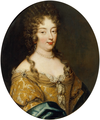Mazarinettes
The Mazarinettes (French: Mazarinettes ) were the seven nieces of the French minister Jules Mazarin , whom he brought to France together with three of his nephews from Italy in 1647 and 1653, in order to subsequently marry them advantageously to members of powerful and influential European noble houses. The cardinal dispelled the arrogance of class of the high nobility with enormous dowries.
family
The girls were the daughters of two of Mazarin's sisters, Laura Margeritha and Geronima, also called Girolama.
Laura's daughters, married Martinozzi, were:
- Laura Martinozzi (* 1635/38/39; † 1687), through marriage to Alfonso IV. D'Este from 1658 Duchess of Modena and Reggio
- Anna Maria Martinozzi (* 1637; † 1672), by marriage to Armand de Bourbon from 1654 Princess of Conti
Daughters of Geronima, married Mancini, were:
- Laura Mancini (* 1636; † 1657), by marriage to Louis I. de Bourbon from 1651 Duchess of Mercœur
- Maria Mancini (* 1639; † 1715), through marriage to Lorenzo Onofrio I. Colonna from 1661 Duchess of Colonna
- Olympia Mancini (* 1639; † 1708), by marriage to Eugen Moritz von Savoyen-Carignan from 1657 Countess of Soissons
- Hortensia Mancini (* 1646; † 1699), by marriage to Armand-Charles de La Porte from 1661 Duchess of Mazarin
- Maria Anna Mancini (* 1649; † 1714), through marriage to Godefroy Maurice de La Tour d'Auvergne from 1662 Duchess of Bouillon
- Portraits
Biographies
When they arrived in France, they were between seven and 13 years old and, despite their comparatively low origins, were accepted by the regent Anna of Austria at the French royal court. The mother of Louis XIV also made sure that some of the Mazarinettes were brought up together with the king and his brother Philippe , who were still under age, in the Palais Royal . This show of favor placed them on a par with the Princes of the Blood .
When the first girls were introduced at court, the French Marshal Villeroy said to Gaston de Bourbon , the Duke of Orléans : “Voilà des petites demoiselles qui présentement ne sont point riches, mais qui bientôt auront de beaux châteaux, de bonnes rentes, de belles pierreries, de bonne vaisselle d'argent, et peut-être de grandes dignités [...] ”(German:“ Little ladies who are not at all rich at the moment, but will soon have beautiful castles, ample income, beautiful jewelry, silver dishes and maybe even high ones Will own titles […] ”). The Mazarinettes not only attracted attention in Paris because of their Italian-Mediterranean appearance, but also attracted a lot of rejection and envy because of the preferential treatment they received from the royal family and as nieces of the "Italian" Mazarin, which was hated by the French nobility. One of the so-called Mazarinades , mockery and pamphlets , which were directed against Mazarin and which were published in great numbers in France between 1648 and 1653, describes the cardinal's nieces as follows:
| French original | German translation |
|---|---|
|
Elles ont les yeux d'un hibou, |
They have the eyes of an owl, |
Other mazarinades insulted them as “dirt princesses ” and “stinking vipers”. During the Fronde, the girls shared the fate of their uncle: They had to leave Paris and go into exile twice, but in the end Jules Mazarin secured his nieces a life of prosperity and carelessness after the end of the uprising through appropriate marriages and wedding gifts.
The most famous of the mazarinettes is Maria Mancini, who is considered the first great love of Louis XIV and therefore had to leave the French court for good shortly before his marriage to the Spanish Infanta Maria Teresa . Her sister Olympia, on the other hand, stayed in Paris as Comtesse de Soissons and is said to have been one of the king's smaller maitresses, at least temporarily.
literature
- Pierre Combescot : Les petites Mazarines . Grasset, Paris 1999, ISBN 2-246-47761-1 .
- Paul Guth: Mazarin. France's rise to world power . Societäts-Verlag, Frankfurt am Main 1973, ISBN 3-7973-0245-2 , pp. 637-670.
- Jacques Hillairet: Les Mazarinettes ou, Les sept nièces de Mazarin . Éditions de Minuit, Paris 1976, ISBN 2-7073-0138-8 .
- Amédée Renée: Mazarin's nieces. Studies of Morals and Characters in the 17th Century . 3. Edition. Rudolf Kuntze, Dresden 1858, pp. 88-99 ( online ).
- Paul de Saint-Victor: Les Mazarines . In: Revue du XIXe siècle. Volume 4 . Paris 1867, pp. 323-331.
- Guy Jean Raoul Eugène Charles Emmanuel de Savoie-Carignan: The seven richest heiresses of France . J. Long, London 1911 ( online ).
Individual evidence
- ^ Sylvia Jurewitz-Freischmidt: Galantes Versailles. The mistresses at the court of the Bourbons . Piper, Munich 2006, ISBN 978-3-492-24494-7 , p. 20.
- ↑ Amédée Renée: Les nièces de Mazarin: Études de mœurs et de caractères au XVIIe siècle . Firmin Didot, Paris 1856, p. 37.
- ^ P. Guth: Mazarin. France's rise to world power , p. 638.
- ^ P. Guth: Mazarin. France's rise to world power , p. 639.







